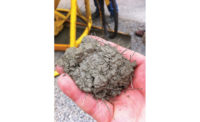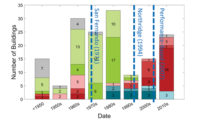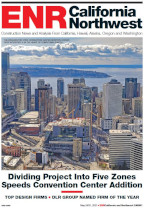Surprisingly positive results from the first of four large-scale tests of reinforced-concrete link beams with embedded structural steel sections have further opened the door to more-constructible concrete towers in highly seismic zones. Link beams over openings in concrete shear-wall cores have long been the bane of builders because of intense reinforcing-steel congestion, which slows construction.
During the first-ever large-scale test, the beam performed much better than anticipated. Given the importance of link beams in core-wall buildings, understanding performance at a meaningful scale is of "critical importance," says Ron Klemencic, president of structural engineer Magnusson Klemencic Associates (MKA), Seattle.
MKA is one of two investigators for the research, which is part of a series of large-scale shake-table tests at the University of California, Los Angeles (UCLA). The research is supported with a grant of up to $283,000 from the Charles Pankow Foundation, with in-kind work contributions from MKA. Other tests on simplified link beams have been performed by MKA and UCLA as part of ongoing efforts to improve constructibility.
Historically, substantial reinforcement is required for coupling beams, creating one of the most congested regions of reinforcement in building construction. Typical installation times for reinforcing range from two to three hours per beam, say the researchers.
Test results will improve understanding of the performance of large-scale link, or coupling, beams with embedded steel. The lessons learned will lead to improved recommendations for design and detailing of embedment zones above and around core wall openings, such as doorways, and to code changes. In turn, this research will lead to link beams that are easier to construct.
In addition, the tests will provide direct evidence that the current recommendations are appropriate and safe for beam sizes that are much more representative of those used in actual practice; the tests also will assess the potential for detailing improvements, say the researchers. Further, the study will boost performance-based seismic design of tall structural-concrete buildings.
GOOD PERFORMANCE
The coupling beam performed exceptionally well, reaching chord rotations of about 13% without significant strength degradation, says John Wallace, UCLA's principal investigator and director of the UCLA Structural/Earthquake Engineering Research Laboratory. The chord rotation translates to 6.5% interstory drift. The code allows only 3% drift under the maximum considered earthquake.
"Even at these excessive demand levels, the embedment performed without issue," says Klemencic.
Another positive outcome was the limited cracking of the embedment area's concrete exterior. "This means repairs after a quake will be limited to the embedment area," says John Hooper, MKA's director of earthquake engineering.











Post a comment to this article
Report Abusive Comment